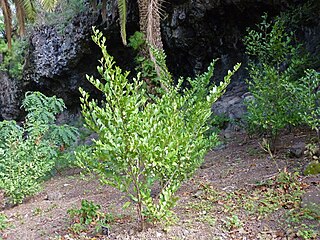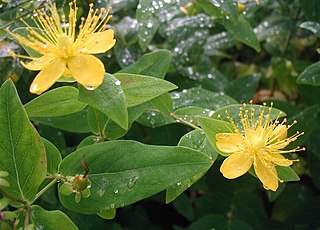
Hypericum is a genus of flowering plants in the family Hypericaceae. The genus has a nearly worldwide distribution, missing only from tropical lowlands, deserts and polar regions. Many Hypericum species are regarded as invasive species and noxious weeds. All members of the genus may be referred to as St. John's wort, and some are known as goatweed. The white or pink flowered marsh St. John's worts of North America and eastern Asia are generally accepted as belonging to the separate genus TriadenumRaf.

Lysimachia is a genus consisting of 193 accepted species of flowering plants traditionally classified in the family Primulaceae. Based on a molecular phylogenetic study it was transferred to the family Myrsinaceae, before this family was later merged into the Primulaceae.

Cyperus is a large genus of about 700 species of sedges, distributed throughout all continents in both tropical and temperate regions.

Ludwigia is a genus of about 82 species of aquatic plants with a cosmopolitan but mainly tropical distribution.

Sparganium (bur-reed) is a genus of flowering plants, described as a genus by Linnaeus in 1753. It is widespread in wet areas in temperate regions of both the Northern and Southern Hemispheres. The plants are perennial marsh plants that can grow to 3.5 m, with epicene flowers.

Visnea is a monotypic genus of flowering plants in family Pentaphylacaceae. The genus contains a single species, Visnea mocanera a tree native to the Canary Islands and Madeira.

Hypericum bupleuroides is a species of perennial flowering plant in the St John's wort family, Hypericaceae. It grows 45–80 centimeters tall, and notably has perfoliate leaves that are fused at the stem. It has pyramid-shaped flower clusters of 1 to 25 flowers with yellow petals in a star-shaped arrangement. The species is found along the Black Sea coast near the Turkish–Georgian border. Hypericum bupleuroides has a small distribution and specific habitat requirements that make it vulnerable to environmental pressures.

Hypericum hircinum is a species of perennial flowering plant in the St John's wort family, Hypericaceae. It is known as goat St John's wort and stinking tutsan; both names refer to the plant's distinctive odor. The species is a bushy shrub that can grow up to 1.5 meters tall, is many-stemmed, and has golden yellow flowers with conspicuous stamens. The plant has been well-documented in botanical literature, with mentions dating back to at least 1627. Carl Linnaeus described H. hircinum several times, including in his 1753 Species Plantarum which established its binomial. At one point the plant was placed into the defunct genus Androsaemum, but it was returned to Hypericum by Norman Robson in 1985.

Hypericum japonicum, known as matted St. John's-wort, is an annual herbaceous flowering plant in the St. John's wort family Hypericaceae, in Hypericum sect. Trigynobrathys.

Hypericum huber-morathii is a flowering plant in the family Hypericaceae, section Adenosepalum, and the type species of the Hypericum huber-morathii group.

Hypericum virginicum, the marsh St. Johns-wort or Virginia marsh St. Johnswort, is a species of flowering plant in the family Hypericaceae. It is native to the central and eastern United States and eastern Canada.
Hypericum antiquum is an extinct species of the genus Hypericum that was present during the Eocene epoch. The species' fossils are the oldest collected of Hypericum, and it is believed that the species is the common ancestor of the tribe Hypericeae. Fossil seeds have been found in Russia, and the predicted paleoregion of the species stretched across Eurasia. It is theorized that one factor leading to the species' extinction is a global cooling at the end of the Eocene that removed much of its habitat.

Hypericum tubulosum, the lesser marsh St. Johnswort or southern marsh St. John's-wort, is a species of flowering plant in the family Hypericaceae. Formerly classified as synonym Triadenum tubulosum, the species is found across the Southern United States and Midwest. It grows in wetlands such as bogs and floodplains.
Hypericum septestum is an extinct species of the genus Hypericum that was present during the Oligocene and Miocene epochs. Its holotype is a fossil seed from the Lower Oligocene that was collected in Western Siberia in 1965, and fossils of the species has also been found in other parts of Russia and in the Czech Republic.
Hypericum tertiaerum is an extinct species of the genus Hypericum. Seeds of H. tertiaerum have been found in Central and Eastern Europe and Siberia, and date from the Lower to Upper Miocene and the Pliocene. While it has sufficient identifying characteristics to place it within Hypericum, there is not enough surviving detail to assign it to any subdivisions within the genus. However, it has been determined that the seeds of H. japonicum, H. virginicum, and H. tubulosum closely resemble those of H. tertiaerum.
Hypericum miocenicum is an extinct species of the genus Hypericum. Seeds of the species have been recorded from the Late Oligocene in Germany, the Late Miocene in Poland (Poznan), and the Pliocene in Germany (Thuringia). It differs from H. septestum, a more frequently found Hypericum paleospecies, by its thinner foveole walls and the shape of its surface cells, which are more rectangular.
Hypericum foveolatum is an extinct species of the genus Hypericum. The paleospecies is known from more recent fossils than many other Hypericum specimens, with fossilized seeds from the Pliocene epoch being found in Russia and Belarus. These seeds have been compared to numerous extant species, including H. elegans, H. tetrapterum, H. attenuatum, H. kamtschaticum, H. yezoënse, H. nudiflorum, and H. microsepalum. However, none of these similar species have the exact same kind of testa surface cells as H. foveolatum.
Hypericum danicum is an extinct species of flowering plant in the family Hypericaceae. The species is known from a fossil seed found among other Hypericum seeds in Italy, and is dated to the Pliocene. It has also been recorded several times from the Søby region of Denmark, also by discovered fossil seeds.
Hypericum bornense is an extinct species of flowering plant in the family Hypericaceae. It was described by botanist D.H. Mai in 1978, based on fossil seed remains from the Early to Late Oligocene found in Saxony, Germany, and Tomsk, Russia. It is likely that the species' habitat was that of a mixed-mesophytic forest.











